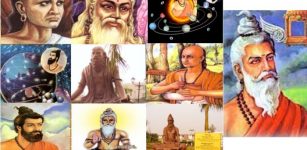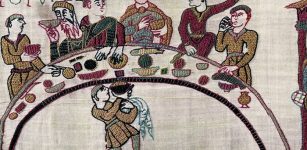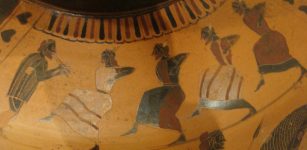The Use Of Surnames Started During The Middle Ages In England
AncientPages.com - Today we all have last names, also called surnames, but how and when did we start using last names? History tells us the custom started in Medieval England in the year 1066.
In the early years of the Middle Ages, most people in Europe lived in small farming villages. Since everyone knew his or her neighbors, and there was little need for last names. This changed however when the population expanded and the towns grew. Suddenly, there was a need to find ways to differentiate between two people who shared the same first name.
Prior to the introduction of surnames in England in 1066, everyone had just one name. Surnames had many different sources, but they can be roughly grouped into four categories: patronymic, locative, occupational or status, and nicknames. Common adjectives often referred to size, such as Little, Short, or Longor to hair color or complexion such as White, Black, or Red (which evolved into Reed). Sometimes, an adjective was combined with a noun to form a byname, like Longfellow or Blackbeard.
A person with a nickname could for example be called Robert Red (symbolic of his hair color). If Robert lost his hair, people would call him Rabert Bald.
See also: Law Of The Innocents
Patronymic names identified people as their fathers' children. Locative surnames identified people based upon where they were born, live or work or the land they own. Occupational or status names were also common. They identified people based upon their jobs or social status. Thomas Smith would have been the Thomas in the village who was the blacksmith. Robert Knight might have chosen his surname to reflect his social standing as a knight.
Because the British were among the first Europeans to settle in North America, many modern American surnames can be traced back to medieval England, Scotland, Ireland, and Wales.
AncientPages.com
Expand for referencesMore From Ancient Pages
-
 10 Remarkable Ancient Indian Sages Familiar With Advanced Technology And Science Long Before Modern Era
Featured Stories | Oct 19, 2015
10 Remarkable Ancient Indian Sages Familiar With Advanced Technology And Science Long Before Modern Era
Featured Stories | Oct 19, 2015 -
 Bayeux Tapestry: Original Location Of Remarkable Romanesque Art – Finally Solved
Archaeology | Oct 26, 2019
Bayeux Tapestry: Original Location Of Remarkable Romanesque Art – Finally Solved
Archaeology | Oct 26, 2019 -
 Dance Was A Gift Of The Gods To Ancient Greeks
Featured Stories | Oct 4, 2021
Dance Was A Gift Of The Gods To Ancient Greeks
Featured Stories | Oct 4, 2021 -
 Ancient DNA Reveals A 50,000-Year-Old Secret And Re-Writes History Of Australia
Archaeology | Mar 8, 2017
Ancient DNA Reveals A 50,000-Year-Old Secret And Re-Writes History Of Australia
Archaeology | Mar 8, 2017 -
 DNA Unravels Mysteries Of The Crannogs, Ancient Artificial Islands Older Than Stonehenge
Archaeology | Oct 10, 2022
DNA Unravels Mysteries Of The Crannogs, Ancient Artificial Islands Older Than Stonehenge
Archaeology | Oct 10, 2022 -
 Vesta And Her Six Vestal Virgins – Highly Venerated Goddess Of Hearth And Family
Featured Stories | Dec 24, 2019
Vesta And Her Six Vestal Virgins – Highly Venerated Goddess Of Hearth And Family
Featured Stories | Dec 24, 2019 -
 War Between Romans And Persians Lasted 721 Years: One Of The World’s Longest Human Conflicts In History
Featured Stories | Apr 18, 2022
War Between Romans And Persians Lasted 721 Years: One Of The World’s Longest Human Conflicts In History
Featured Stories | Apr 18, 2022 -
 7,000-Year-Old Underwater Road Discovered In Adriatic Sea Off Korcula Island
Archaeology | May 11, 2023
7,000-Year-Old Underwater Road Discovered In Adriatic Sea Off Korcula Island
Archaeology | May 11, 2023 -
 On This Day In History: Taoist Monk Discovers Dunhuang Manuscripts In Mogao Caves, China – On June 25, 1900
News | Jun 25, 2016
On This Day In History: Taoist Monk Discovers Dunhuang Manuscripts In Mogao Caves, China – On June 25, 1900
News | Jun 25, 2016 -
 Unsolved Archaeological Mystery Of Ta Prohm Temple, Cambodia
Civilizations | Sep 3, 2018
Unsolved Archaeological Mystery Of Ta Prohm Temple, Cambodia
Civilizations | Sep 3, 2018 -
 Unique Historical Discovery – Wreck Of Vasa’s Sister Ship Äpplet Found Off Swedish Coast!
Archaeology | Oct 25, 2022
Unique Historical Discovery – Wreck Of Vasa’s Sister Ship Äpplet Found Off Swedish Coast!
Archaeology | Oct 25, 2022 -
 Mystery Of Mexico’s Bizarre Mummy May Never Be Solved
Featured Stories | Sep 17, 2024
Mystery Of Mexico’s Bizarre Mummy May Never Be Solved
Featured Stories | Sep 17, 2024 -
 Myths And Legends Reveal Ancient Turtle Worship Linked To The Creation Of The World
Featured Stories | Jun 24, 2020
Myths And Legends Reveal Ancient Turtle Worship Linked To The Creation Of The World
Featured Stories | Jun 24, 2020 -
 On This Day In History: Tokugawa Shogunate Begins In Japan After Historical Battle – On Oct 21, 1600
News | Oct 21, 2016
On This Day In History: Tokugawa Shogunate Begins In Japan After Historical Battle – On Oct 21, 1600
News | Oct 21, 2016 -
 More Than 27,000 Artifacts Illegally Collected By ‘Expert In Archaeology’ – Seized In France
Artifacts | Dec 18, 2020
More Than 27,000 Artifacts Illegally Collected By ‘Expert In Archaeology’ – Seized In France
Artifacts | Dec 18, 2020 -
 Ancient Medical Machine Ahead Of Its Time Hidden In Emperor’s Temple – Secret Science Knowledge Examined
Ancient Mysteries | Apr 20, 2018
Ancient Medical Machine Ahead Of Its Time Hidden In Emperor’s Temple – Secret Science Knowledge Examined
Ancient Mysteries | Apr 20, 2018 -
 Thousands Of Petroglyphs And Inscriptions In Wadi Rum, Jordan – 12,000 Years Of Human Occupation
Civilizations | Oct 23, 2018
Thousands Of Petroglyphs And Inscriptions In Wadi Rum, Jordan – 12,000 Years Of Human Occupation
Civilizations | Oct 23, 2018 -
 What Happened To The Ancient Tribe That Entered A Secret Underground World And Never Came Back?
Ancient Mysteries | Feb 1, 2021
What Happened To The Ancient Tribe That Entered A Secret Underground World And Never Came Back?
Ancient Mysteries | Feb 1, 2021 -
 Encounter Between Neanderthals And Homo Sapiens – Genome Study Traces The History
DNA | Oct 18, 2023
Encounter Between Neanderthals And Homo Sapiens – Genome Study Traces The History
DNA | Oct 18, 2023 -
 1,900-year-old ‘water law’ unearthed in Laodicea
Civilizations | Aug 26, 2015
1,900-year-old ‘water law’ unearthed in Laodicea
Civilizations | Aug 26, 2015

